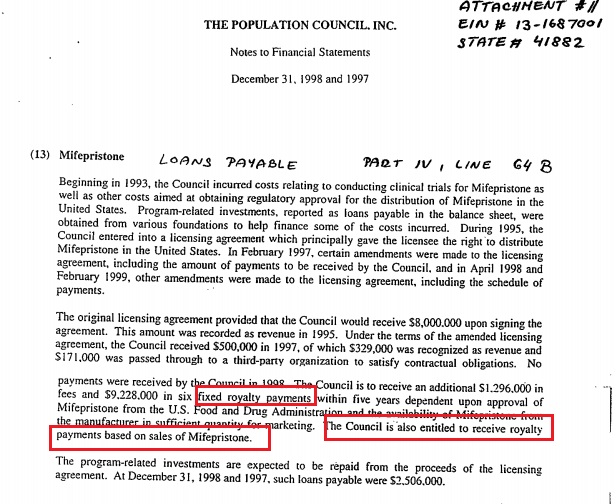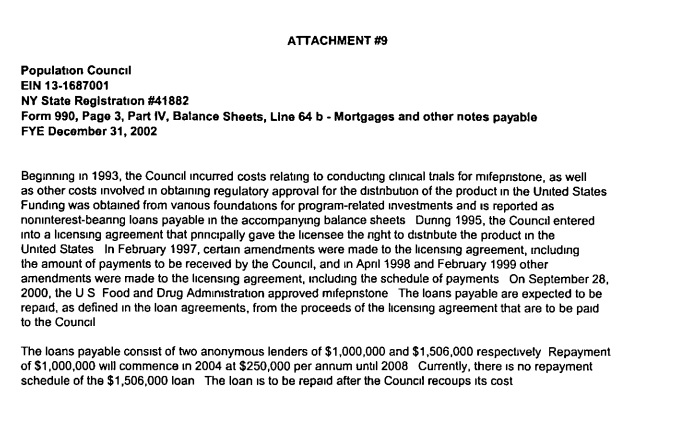Live Action News has uncovered a document which indicates that the Population Council, a non-profit founded by eugenicists (which brought the abortion pill to the U.S. and then created manufacturer DANCO Laboratories to market the drug known as mifepristone) was originally set up to receive royalties from sales of the abortion pill.
The information was found within the organization’s 1998 990 and is seen in the image below. A review of Population Council annual reports reveal that, despite the group’s creation of an abortion pill company, millions of taxpayer dollars have been funneled to the Population Council since the late 1990’s.

Population Council RU486 abortion pill Royalty 1998
Live Action News previously documented:
- 1993 – President Bill Clinton signed an executive order directing the FDA to expedite marketing of the abortion pill.
- 1994 – With encouragement of the Clinton administration, French manufacturer Roussel-Uclaf assigned U.S. rights of marketing and distribution of RU-486 over to the Population Council.
- The right to distribute the abortion pill was later handed over to DANCO Laboratories, a sub-licensee of the Population Council.
- 1996 – The David and Lucile Packard Foundation seeded DANCO with $14.2 million. Packard would go on to fund Gynuity Health Projects, which is currently conducting abortion pill clinical trials as well as a number of studies, to expand the drug further.
A substantial amount of the Population Council’s current and past funding appears to be from the U.S. government as well as royalty revenue. Royalty revenue was rarely defined in all the reports Live Action News reviewed (linked below) so it is impossible to know if the Population Council is still receiving royalty dollars from the abortion pill. “Royalty” could mean multiple things and could even include payments made for investments — or as one Population Council document describes it, “gifts of oil, gas, and mineral interests.'” However, it could also be as another Population Control document defines it: “generated from the licensing of Council-developed products,” such as the royalty deal they brokered over mifepristone, detailed in the 2002 990 (image below).

Population Council Royalty from abortion pill from 2002 990
While it is unclear whether the Population Council continues to profit from the abortion pill via a royalty payment, it is undeniable that U.S. taxpayers are subsidizing their work. A review of the organization’s annual reports reveal the following:
- 2018: $39.5 million from taxpayers – $22.7 million royalties (Note: A milestone payment of $20 million tied to a product licensing agreement was recognized as revenue in 2018.)
- 2017: $37.7 million from taxpayers – $11 million royalties
- 2016: $38.6 million from taxpayers – $4 million royalties
- 2015: $35.6 million from taxpayers – $2.8 million royalties
- 2014: $37.8 million from taxpayers – $2.4 million royalties
- 2013: $37.1 million from taxpayers – $2.2 million royalties
- 2012: $34.8 million from taxpayers – $6.5 million royalties
- 2011: $40.8 million from taxpayers – $8 million royalties
- 2010: $27 million from taxpayers – $11.1 in royalties (Note: In February 2010, the Council signed a licensing agreement with Watson Pharmaceuticals, Inc., granting them the North American rights to the contraceptive vaginal ring. This agreement led to a 48 percent increase in the Council’s royalty income for 2010.)
- 2009: $58 million from taxpayers – $6.2 million royalties
- 2008: $40.5 million from taxpayers – $5.5 million royalties
- 2007: $44.7 million from taxpayers – $4.6 million royalties
- 2006: $38.4 million from taxpayers – $ 6.2 million royalties
- 2005: $40.1 million from taxpayers – $6.9 million royalties
- 2004: Taxpayer contribution not stated – $4.8 million royalties
- 2003: $39.5 million from taxpayers – $4,910 in royalties
- 2002: $5,301 in royalties
- 2001: $37.6 million from taxpayers – $4.9 million royalties
- 2000: $6.3 million royalties (Note: Council signed an agreement with the pharmaceutical company Schering AG, beginning the royalty stream for MENT™, a synthetic testosterone substitute that the Council has been investigating for male contraception and hormone replacement therapy.)
- 1999: $39.5 million from taxpayers – $5.1 million royalties
In addition to the United States taxpayers, the Population Council is funded by the same billionaire pro-abortion philanthropists who seeded abortion pill manufacturer DANCO Laboratories, namely the Buffett Foundation (Warren Buffett) and the Packard Foundation — and others:
- Bill and Melinda Gates Foundation
- MacArthur Foundation
- Hewlett Foundation
- Ford Foundation
- Kellogg Foundation
Live Action News has previously documented that due to abortion politics, DANCO Laboratories has been cloaked in secrecy, a fact confirmed in several media reports on DANCO’s early days.
- Washington Post (2000): the FDA “took the unprecedented step of refusing to disclose the name or location of the manufacturer” of the abortion pill.
- Washington Post (2000): the “agency broke with precedent by not publishing the names of the experts who reviewed RU-486 for the agency.”
- LA Times (2000): “Danco refuses to release the names of its executives and investors. The company even persuaded the Food and Drug Administration to keep secret the location of the factory where the abortion drug will be produced…. The FDA acceded to Danco’s request that the name of its manufacturer be kept secret — and even shielded the names of the FDA researchers who had overseen the pill’s approval.”
- NY Daily News (2000): “The pill’s 11-year journey to the United States included a cloak-and-dagger scheme to hide the identities of participants from anti-abortion activists, allegations of fraud, a dozen lawsuits, and a price tag of at least $50 million…. Citing fear… Danco refuses to release the names of its executives and investors. The company even persuaded the Food and Drug Administration to keep secret the location of the factory where the abortion drug will be produced…. In a strange twist, the FDA acceded to Danco’s request that the name of its manufacturer be kept secret — and even shielded the names of the FDA researchers who had overseen the pill’s approval.”
- NY Times (1999): “‘I can’t think of any precedent for that kind of secrecy,” says Lars Noah, a law professor at the University of Florida whose expertise is food and drug law. ”I’ve never heard of a situation where, with the blessing of the F.D.A., you could keep the manufacturer of a drug secret. Then again, it’s hard to think of any other pharmaceutical with the potential political impact this one has.'”
Today, the abortion pill accounts for 40 percent of reported abortions in the United states. According to the FDA, “The estimated number of women who have used mifepristone in the U.S. for the medical termination of pregnancy through the end of December 2018 is approximately 3.7 million women…” But, apparently that is not enough because, as Live Action News has documented multiple times, the abortion industry is pushing for the abortion pill to be moved out of clinics and hospitals into schools and over pharmacy counters, as so-called self-managed abortions.
Meanwhile, in 2018, the FDA updated its adverse effects reports on just legally dispensed abortion pills, revealing 24 deaths of women associated with the abortion pill since its approval. The report documents that abortion pills have caused nearly 4,200 reported adverse effects, including 1,042 hospitalizations, nearly 600 instances of blood loss requiring transfusions and other serious complications. But, as Live Action News previously noted, under 2016 changes, abortion pill manufacturer DANCO no longer has to report non-fatal adverse effects, so we have no way of knowing what the number really is.
Editor’s Note, 4/18/21: The FDA has received reports of serious adverse events in women who took Mifeprex. As of December 31, 2018, there were reports of 24 deaths of women associated with Mifeprex since the product was approved in September 2000, including two cases of ectopic pregnancy resulting in death; and several cases of severe systemic infection (also called sepsis), including some that were fatal.”
The adverse events cannot with certainty be causally attributed to mifepristone because of concurrent use of other drugs, other medical or surgical treatments, co-existing medical conditions, and information gaps about patient health status and clinical management of the patient. A summary report of adverse events that reflects data through December 31, 2018 is here.
“Like” Live Action News on Facebook for more pro-life news and commentary!







